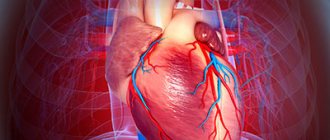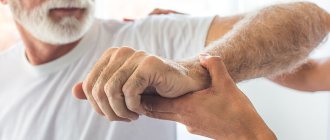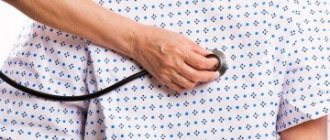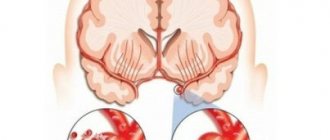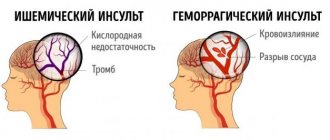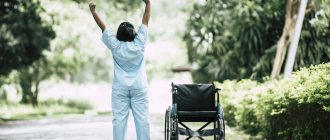During the rehabilitation period after acute cerebrovascular accident (ACVA), the patient may develop complications and side effects of therapy of varying degrees of complexity. If the leg swells after a stroke, this may indicate a violation of the rules of patient care or the development of a pathological process. Before taking any action, you should discuss the problem with your doctor. The specialist will carry out the necessary diagnostic procedures and prescribe the optimal treatment option.
About the disease
Stroke – translated means “strike, attack”, “paralysis” – an acute disturbance of blood circulation in the brain. The disease develops suddenly (from a few minutes to 1-2 days), manifests itself against the background of overexertion.
Reference. The first descriptions of the disease were made by Hippocrates back in 460 BC.
There are three types of disease:
- Ischemic stroke (up to 75–85% of cases), affects people over 60 years of age;
- Hemorrhagic stroke (up to 20%) occurs in people with hypertension aged 40–60 years;
- Subarachnoid hemorrhage (up to 5%) – rupture of an aneurysm, brain injury.
Important! Every 1-2 minutes, someone in Russia develops a stroke. Up to 80% of stroke survivors become disabled, 20–30% of them require constant care.
Read also
Encephalopathy
These can range from minor abnormalities in brain function to serious neurological disorders that require urgent treatment.
Encephalopathy can be congenital or acquired. Congenital… Read more
Transient ischemic attack (TIA)
What it is? Why is this happening? Is this condition dangerous? What to do if doctors make such a diagnosis? These questions are always asked by patients who come to see a neurologist. According to classification...
More details
Chronic cerebral ischemia
One of the most common diagnoses at an appointment with a neurologist for patients in the older age group is chronic cerebral circulatory failure, discirculatory encephalopathy. According to…
More details
Vegetative-vascular dystonia
Vegetative-vascular dystonia is a dysregulation of the autonomic nervous system, which manifests itself in the form of various clinical symptoms. This disease is diagnosed at different times...
More details
Alzheimer's disease
47,000,000 people suffer from dementia in the world. Doctors call Alzheimer's disease the most common cause of dementia. Alzheimer's disease is a progressive neurodegenerative disease accompanied by...
More details
Why do limbs swell?
A stroke is a powerful blow to the left and right hemispheres of the brain, disabling not only the central nervous system, but the functioning of the entire organism as a whole.
If the cerebellum and right hemisphere, which is responsible for the physical functions of the body, are damaged, the patient experiences convulsions, swelling, numbness, sensitivity is lost, and paralysis of the limbs is possible.
This is why patients often complain that their legs are swollen.
This disease is terrible precisely because of its consequences - the functioning of the kidneys, heart, and genitourinary system is disrupted. Swelling of the legs (failure of fluid exchange) is a consequence of these disorders.
Important! Swelling of the legs appears within 1-2 hours after a stroke; emergency medical assistance is necessary to prevent a recurrence of the crisis.
Next we will tell you the specific reasons for the violation.
Heart failure
As a result of unstable heart function, limited blood supply to the legs or arms occurs. After a stroke, the heart muscle cannot cope with the volume of blood, and stagnation occurs. Reason: when the right side is affected, the blood, overflowing the veins, penetrates the tissues of the arms, legs and liver.
Varicose veins
After a stroke, the functioning of the entire circulatory system is disrupted - the vessels dilate, the walls fill with blood, become thin, as a result, the legs swell and greatly increase in size.
It is important to prevent the formation of blood clots by increasing the tone of the vessel walls and improving blood flow.
Thrombosis
After a stroke, with temporary paralysis, the patient practically does not move, and is always in a supine position. The blood stagnates and becomes thick not only in small capillaries, but also in the deep veins of the legs and arms. The cells “starve”, the limbs go numb, severe swelling occurs, accompanied by pain and bluish skin. People with varicose veins and other vascular diseases are especially at risk for thrombosis.
It is impossible to cure thrombosis on your own with massage or special exercises; urgent surgery is required (removal of a blood clot or installation of special filter devices that “catch” clots).
Kidney complications
After a stroke, the water balance is disrupted, the body can accumulate water, and dehydration is also possible. A distinctive sign is that not only the legs and arms swell, but also the face. The swelling is pale, warm, soft to the touch.
Possible necrosis and kidney failure; Inpatient treatment, special medications, and massage are required. Kidney prevention is very important.
When paralyzed
After a stroke, temporary immobilization of the right or left side is possible (sensitivity and muscle tone are impaired).
In this case, swelling of the paralyzed leg is a common occurrence.
Reasons why a paralyzed leg swells:
- Clamping of large vessels. When paralyzed, a person does not feel discomfort, cannot roll over, or change body position. And if a bedridden patient lies in one position for a long time, the vascular system is pinched, blood circulation is disrupted, and swelling appears.
- Stagnation of venous blood and lymph. The hanging position of the foot or hand is unacceptable - blood stagnates in the paralyzed limbs. The situation is aggravated by muscle weakness. As you know, muscle work ensures normal blood flow.
- Thrombosis. A distinctive feature is that the leg becomes hot, and pain occurs when lightly pressed. In this case, immediate assistance from a specialist is required.
Some more probable causes of the symptom
In some cases, a paralyzed leg after a stroke swells due to functional failures in the functioning of internal organs. Often the pathological process spreads to a healthy limb. Treatment of the symptom here is directly related to the elimination of the provoking factor. The approaches listed above will not give a lasting effect. Only after the cause of the condition has been eliminated or specialized therapy has begun, the clinical picture begins to change for the better.
Chronic heart failure
If the patient had this condition initially, then after the stroke it will progress due to lack of physical activity. The heart is no longer able to cope with processing the entire volume of blood in the usual rhythm, so fluid stagnates in the lower extremities and they swell. The capillaries are subject to increased stress, which causes the blood plasma to peel off and enter the intercellular space.
The following techniques are used to combat the condition:
- the load on the heart decreases;
- the endurance of the heart muscle increases;
- tissue swelling is eliminated.
Swelling is eliminated by taking diuretics. Furasemide, Torasemide, and Hypothiazide are used for medicinal purposes. They come in combination with anticoagulants and antiplatelet agents. If your legs swell, be sure to monitor your pulse and blood pressure.
Varicose veins
This condition is characterized by a characteristic clinical picture, thanks to which an experienced doctor, after examination, will make the correct diagnosis and prescribe appropriate treatment. Drug therapy is aimed at normalizing blood flow in the legs, increasing the tone of the vascular walls and preventing the formation of blood clots. The main task falls on venotonics. Preparations with diosmin – “Detralex”, “Phlebodia” - have a high degree of effectiveness.
Read also: Rehabilitation after a stroke
Sometimes physiotherapeutic treatment of the swollen area and the use of compression garments are allowed. Treatment should begin at the first symptoms of the disease. Against this background, thrombophlebitis can quickly develop, which in this situation is extremely dangerous and does not respond well to therapy.
Acute deep vein thrombosis
Vava filter for thrombosis
In this case, swelling of the limb is one-sided, accompanied by cyanosis of the skin and severe pain. If the lumen of the inferior vena cava is blocked, both legs swell at once. In the initial stages of the disease, it is usually possible to manage with conservative therapy - taking anticoagulants, for example, Heparin. In advanced cases, removal of the blood clot by surgery or installation of a vena cava filter is required.
Kidney diseases
Acute or chronic glomerulonephritis, as well as renal failure, often cause pathological processes that result in stroke. It turns out that the diseases are closely related to each other. This is confirmed by the fact that after suffering a blow, the severity of problems with the urinary system only intensifies.
In this case, swelling affects not only the legs, but also the arms, and a pasty appearance of the face is observed. The affected areas are pale, warm and soft. The treatment process is based on the fight against the underlying disease and its causes. With the development of renal failure, diuretics are used, often in large doses.
If the symptom is not dealt with, swelling can spread to the patient’s back, which can lead to interruptions in the functioning of the heart.
If your legs swell after a stroke, you must immediately respond to the unpleasant process. Lack of treatment can lead to the development of even more serious complications, for example, tissue suppuration or the development of bedsores. These conditions not only require more aggressive treatment, but also slow down the process of restoration of functionality and motor activity of the limbs.
Treatment
Treatment of leg swelling is carried out comprehensively; therapy includes taking medications, regular massage, and moderate exercises involving the limb. Only in combination these methods will help get rid of swelling and prevent complications.
Massage
Massage is an additional method of recovery after a stroke. Massage stimulates the functioning of blood vessels, accelerates blood flow, relaxes muscles, restores their strength, and relieves swelling.
Massage is prescribed in the first month of recovery. The course is long, at least 14-30 days, depending on existing complications, type of stroke, etc.
Important! In case of cerebral infarction without complications, massage is performed 2-3 days after the crisis; in case of hemorrhage - after 6-7 days.
Time of implementation : immediately after sleep, in the morning or before therapeutic exercises.
Duration – from 10 minutes, time gradually increases to 30 minutes.
Frequency day .
The entire course and number of sessions are prescribed by the doctor.
Carrying out conditions – air temperature not less than 20 ᵒС; Only the massaged part is exposed, the patient is covered with a blanket; massage is performed before meals or 2 hours after meals; after the massage – rest for 15 minutes.
Massage movements are directed from the foot to the knee, then to the inguinal lymph nodes. To quickly relieve swelling (to narrow blood vessels), massage is done with ice cubes, which include a decoction of oak bark and eucalyptus.
Additional remedies: cool gauze compresses (wrapped around the leg) are applied at night.
Gymnastics
Gymnastics is a prerequisite for relieving leg swelling.
To return the vessels to their previous state and normalize blood flow, feasible physical activity is necessary.
Time : in the morning after the massage.
Duration – at least 20 minutes.
Frequency – at least 2 times a day.
If possible, it is advisable to visit the pool and gym.
In the afternoon, exercise can be replaced by a walk. Fresh air, nature, positive emotions contribute to recovery.
For paralyzed limbs, passive gymnastics is performed.
Medicines
Attention! All medications are prescribed only by a doctor; self-medication is dangerous for the patient’s life.
In the initial stages, medications that thin the blood and prevent blood clotting (heparin, warfarin) are most often prescribed.
Diuretics - furosemide, torasemide, etc. can be used intravenously, intramuscularly and in tablets. Daily dose – from 10 mg. Negative consequences may occur - arrhythmia, exacerbation of heart disease.
For varicose veins, venotonics are added (detralex, phlebodia, etc.). For bedridden patients, an elastic bandage and special underwear are used.
Don’t forget about folk remedies - decoctions, baths, tinctures effectively relieve swelling:
- Carrot, cucumber, lemon juice are diuretics (drink 3 times a day before meals);
- To increase overall tone and quickly relieve swelling, it is recommended to mix the yolk with 3 grams of milkweed (use 2-3 times a day);
- Tincture of mint or flax relieves swelling after 3-4 days;
- Baths of mustard, sea salt and mint tone muscles and increase blood flow (every day before bed for 6 days).
What to do if your legs are swollen?
In order to reduce swelling, it is necessary to reduce physical activity on the lower extremities; ice can be applied to the swollen area. If the vein valves are insufficient, leg bandaging is performed. It is recommended to place a pillow under your feet while sleeping to enhance venous return to the heart. For heart failure, medications are prescribed.
If you find swelling in your legs, contact a cardiologist at the FIRST NEUROLOGY clinic. In our work we use modern diagnostic and treatment methods
Prevention
In order not to worsen the patient’s condition and prevent complications, immediately after a stroke you should take into account the necessary rules and recommendations:
- Fluid intake (in any form) is no more than 1 liter per day. The patient's urine should be excreted in the same volume;
- Diet (allowable amount of salt – 1.5 g per day);
- every 2 hours , at night - every 5 hours;
- It is unacceptable for limbs to hang from the bed (it is better to raise your legs and place them on a thick pillow);
- Massage and exercises should be performed regularly (even simple movements help restore blood circulation);
- In a sitting position, the back should rest on a backrest or support , pillows are placed under the arms, the position of the hands is palms down, fingers extended.
Useful video on the topic:


